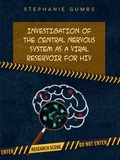Investigation of the central nervous system as a viral reservoir for HIV

Gumbs, Stephanie
- Promoter:
- Prof.dr. E.J.H.J. (Emmanuel) Wiertz & prof.dr. A.M.J. (Anne) Wensing
- Co-promoter:
- Dr. M. (Monique) Nijhuis & dr. L.D. (Lotje) de Witte
- Research group:
- Wensing Nijhuis , Wiertz
- Date:
- February 16, 2023
- Time:
- 12:15 h
Summary
Antiretroviral therapy (ART) has substantially improved treatment outcomes for people with HIV (PWH) by effectively suppressing viral replication. However, HIV hides in resting cells, and the achievement of HIV cure, therefore, relies on the eradication or permanent silencing of these infected resting cells.
We investigated whether the central nervous system (CNS) can serve as an anatomical reservoir for HIV and in which brain cells HIV might be hiding. Therefore, we used a unique collection of samples, obtained from blood, cerebrospinal fluid (CSF), and brain biopsies from untreated and treated PWH. Importantly, we detected intact proviral DNA in the CNS despite long-term effective treatment. Furthermore, we found that some individuals had significant differences between the virus population in the blood and the CSF, indicating that HIV can infect and replicate within cells in the CNS. Using microglial culture models, we demonstrated that microglia support productive HIV infection. Based upon our newly developed cerebral organoid culture model, also known as “mini-brains”, we showed microglia to be the only HIV target cell in the CNS.
Overall, we demonstrated that the CNS, particularly microglial cells, can support HIV infection and replication and also harbor intact HIV DNA despite long-term ART and viral suppression, suggesting that the CNS can function as a viral reservoir. With this knowledge, we advocate for the inclusion of the CNS in future HIV eradication strategies.